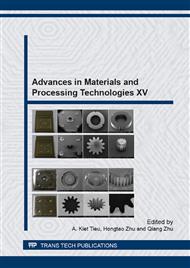p.678
p.687
p.697
p.705
p.712
p.725
p.732
p.741
p.750
Fabrication of a Micro Lens Array with a High Filling Factor Using a Direct Molding Method
Abstract:
In recent years, micro lens arrays have played a crucial role in optical illumination systems. The function of micro lens arrays (MLAs) is to create a uniform light intensity or shape the light profile. Polymers that are commonly used as MLAs have several advantages, such as cost effectiveness, light weight, and easy formation. In general, the ultra-precision diamond-turning technique and plastic injection molding technique have been combined to fabricate MLAs with polymer materials. However, residual stress and non-balance injection pressure are produced on MLAs during injecting processing. Therefore, this paper presents the fabrication of MLAs using a direct molding method (DMM). The STAVAX with electroless nickel coating and PMMA were used as the mold and polymer preform, respectively. First, a mold of MLA with 100% filling factor was fabricated using the ultra-precision diamond-turning technique. A high filling factor can decrease the non-effective area of the MLA in an optical system. Subsequently, an MLA was formed on the PMMA surface using DMM processing. This paper shows the DMM process parameters, including molding temperature, molding force, and cooling rate. Moreover, the profile of the MLA was measured using a laser confocal microscope. Finally, a high filling factor MLA with a diameter of 11.5 mm, and lenses with a height of 8.5 μm and a radius of 470 μm were formed on PMMA.
Info:
Periodical:
Pages:
712-721
Citation:
Online since:
November 2013
Authors:
Price:
Сopyright:
© 2014 Trans Tech Publications Ltd. All Rights Reserved
Share:
Citation:


